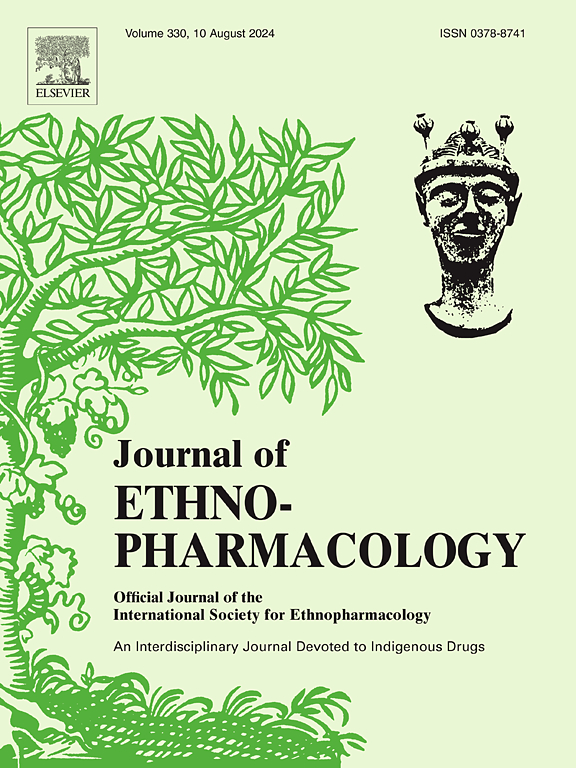七肾桃红颗粒通过调节线粒体分裂和线粒体自噬平衡减轻心力衰竭。
IF 4.8
2区 医学
Q1 CHEMISTRY, MEDICINAL
引用次数: 0
摘要
民族药理学相关性:心力衰竭(HF)仍然是心血管治疗的关键挑战。根据中医气血理论研制的芪肾桃红颗粒(QSTH),通过随机对照试验证明了其治疗心衰的临床疗效。然而,它们的确切作用机制尚不清楚。目的:探讨QSTH在改善心衰过程中调节线粒体稳态的作用机制。方法:建立小鼠心衰模型和心肌细胞肥大模型,进行QSTH干预。通过超声心动图和组织病理学染色评估心脏功能和结构完整性。采用Western blot法定量测定小鼠体内和体外线粒体裂变(FIS1、MFF)和线粒体自噬标志物(p62、LC3B、PARKIN)。采用透射电子显微镜(TEM)和双光子激发偏振荧光显微镜(TEPF)分析线粒体超微结构。体外机制研究采用途径抑制剂和Pink1 siRNA来验证调控途径。通过Western blot、qRT-PCR和免疫荧光技术评估分子变化。结果:QSTH通过抑制线粒体裂变蛋白(FIS1, MFF)和激活线粒体自噬,改善HF小鼠心肌病理和心功能,表明LC3B和PARKIN表达升高,p62水平降低。TEPF显微镜显示,qsth处理的心肌细胞线粒体网络完整性增强。在体外,QSTH通过调节活性氧(ROS)、线粒体膜电位和细胞凋亡来减轻肥大。机制上,QSTH激活PINK1表达/磷酸化,抑制CaMKIIδ T287磷酸化,调节DRP1 S616磷酸化,从而通过CaMKIIδ-DRP1-PINK1通路平衡线粒体分裂-自噬动力学。结论:QSTH通过调节camkii - δ- drp1 - pink1通路,恢复心衰模型心肌细胞线粒体稳态,有效减轻心肌肥大,改善心功能,减轻纤维化。本文章由计算机程序翻译,如有差异,请以英文原文为准。

Qishentaohong granules alleviate heart failure by modulating mitochondrial fission and mitophagy balance
Ethnopharmacological relevance
Heart failure (HF) remains a critical challenge in cardiovascular therapeutics. Qishentaohong granules (QSTH), formulated under the traditional Chinese medicine Qi-Blood theory, have demonstrated clinical efficacy in HF management through randomized controlled trials. However, their precise mechanisms of action remain unclear.
Objective
To investigate the mechanistic role of QSTH in regulating mitochondrial homeostasis for HF amelioration.
Methods
HF murine models and cardiomyocyte hypertrophy models were developed for QSTH intervention. Cardiac function and structural integrity were assessed via echocardiography and histopathological staining. Mitochondrial fission (FIS1, MFF) and mitophagy markers (p62, LC3B, PARKIN) were quantified by Western blot in vivo and in vitro. Mitochondrial ultrastructure was analyzed using transmission electron microscopy (TEM) and two-photon excitation polarized fluorescence (TEPF) microscopy. In vitro mechanistic studies employed pathway inhibitors and Pink1 siRNA to validate regulatory pathways. Molecular alterations were evaluated through Western blot, qRT-PCR, and immunofluorescence.
Results
QSTH ameliorated myocardial pathology and cardiac function in HF mice through suppression of mitochondrial fission proteins (FIS1, MFF) and activation of mitophagy, indicated by elevated LC3B and PARKIN expression coupled with reduced p62 levels. TEPF microscopy revealed enhanced mitochondrial network integrity in QSTH-treated cardiomyocytes. In vitro, QSTH attenuated hypertrophy by modulating reactive oxygen species (ROS), mitochondrial membrane potential, and apoptosis. Mechanistically, QSTH activated PINK1 expression/phosphorylation, inhibited CaMKIIδ T287 phosphorylation, and regulated DRP1 S616 phosphorylation, thereby balancing mitochondrial fission-mitophagy dynamics via the CaMKIIδ-DRP1-PINK1 pathway.
Conclusion
QSTH restores cardiomyocyte mitochondrial homeostasis through modulation of the CaMKIIδ-DRP1-PINK1 pathway, effectively attenuating hypertrophy, improving cardiac function, and reducing fibrosis in HF models.
求助全文
通过发布文献求助,成功后即可免费获取论文全文。
去求助
来源期刊

Journal of ethnopharmacology
医学-全科医学与补充医学
CiteScore
10.30
自引率
5.60%
发文量
967
审稿时长
77 days
期刊介绍:
The Journal of Ethnopharmacology is dedicated to the exchange of information and understandings about people''s use of plants, fungi, animals, microorganisms and minerals and their biological and pharmacological effects based on the principles established through international conventions. Early people confronted with illness and disease, discovered a wealth of useful therapeutic agents in the plant and animal kingdoms. The empirical knowledge of these medicinal substances and their toxic potential was passed on by oral tradition and sometimes recorded in herbals and other texts on materia medica. Many valuable drugs of today (e.g., atropine, ephedrine, tubocurarine, digoxin, reserpine) came into use through the study of indigenous remedies. Chemists continue to use plant-derived drugs (e.g., morphine, taxol, physostigmine, quinidine, emetine) as prototypes in their attempts to develop more effective and less toxic medicinals.
 求助内容:
求助内容: 应助结果提醒方式:
应助结果提醒方式:


